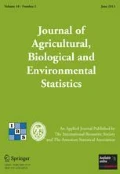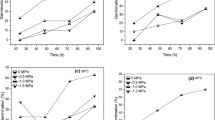Abstract
Current methodology to quantify temperature characteristics in germination of seeds is predominantly based on analysis of the time to reach a given germination fraction, that is, the quantiles in the distribution of the germination time of a seed. In practice interpolation between observed germination fractions at given monitoring times is used to obtain the time to reach a given germination fraction. As a consequence the obtained value will be highly dependent on the actual monitoring scheme used in the experiment. In this paper a link between currently used quantile models for the germination time and a specific type of accelerated failure time models is provided. As a consequence the observed number of germinated seeds at given monitoring times may be analysed directly by a grouped time-to-event model from which characteristics of the temperature profile may be identified and estimated. Simulations indicate that the performance of the proposed methodology is satisfactory irrespective of the actual monitoring scheme. Finally, the model is applied to a quinoa germination experiment studying the impact of soil salinity.
Similar content being viewed by others
References
Andersen, P. K., Borgan, Ø., Gill, R. D., and Keiding, N. (1993), Statistical Models Based on Counting Processes, New York: Springer.
Feder, P. I. (1975), “On Asymptotic Distribution Theory in Segmented Regression Problems—Identified Case,” Annals of Statistics, 3, 49–83.
Garcia-Huidobro, J., Monteith, J. L., and Squire, G. R. (1982), “Time, Temperature and Germination of Pearl Millet,” Journal of Experimental Botany, 33, 297–302.
Giolo, S. R., Colosimo, E. A., and Demetrio, C. G. B. (2009), “Different Approaches for Modeling Grouped Survival Data: A Mango Tree Study,” Journal of Agricultural, Biological, and Environmental Statistics, 14, 154–169.
Hardergree, S. P. (2006), “Predicting Germination Response to Temperature. I. Cardinal-Temperature Models and Subpopulation-Specific Regression,” Annals of Botany, 97, 1115–1125.
Hardergree, S. P., and Winstral, A. H. (2006), “Predicting Germination Response to Temperature. II. Three-Dimensional Regression, Statistical Gridding and Iterative-Probit Optimization Using Measured and Interpolated-Subpopulation Data,” Annals of Botany, 98, 403–410.
Jacobsen, S.-E., and Bach, A. P. (1998), “The Influence of Temperature on Seed Germination Rate in Quinoa (Chenopodim Quinoa Willd),” Seed Science and Technology, 26, 515–523.
Jacobsen, S.-E., Mujica, A., and Jensen, C. R. (2003), “The Resistance of Quinoa (Chenopodim Quinoa Willd) to Adverse Abiotic Factors,” Food Reviews International, 19, 99–109.
Koyro, H. W., Geißler, N., Hussin, S., and Huchzermeyer, B. (2008), “Survival at Extreme Locations: Life Strategies of Halophytes—The Long Way From System Ecology, Whole Plant Physiology, Cell Biochemistry and Molecular Aspects Back to Sustainable Utilization at Field Sited,” in Biosaline Agriculture and High Salinity Tolerance, eds. C. Abdelly, M. Ötztürck, M. Ashraf, and C. Grignon, Basel: Birkhäuser, pp. 1–20.
Liang, K. Y., and Zeger, S. L. (1989), “Longitudinal Data Analysis Using Generalized Linear Models,” Biometrika, 73, 13–22.
Munns, R., and Tester, M. (2008), “Mechanisms of Salinity Tolerance,” Annual Review of Plant Biology, 59, 651–681.
Pipper, C. B., and Ritz, C. (2007), “Checking the Grouped Data Version of the Cox Model for Interval-Grouped Survival Data,” Scandinavian Journal of Statistics, 34, 405–418.
Pipper, C. B., Ritz, C., and Scheike, T. H. (2011), “Explained Variation in a Fully Specified Model for Data-Grouped Survival Data,” Biometrics, 67, 1361–1368.
R Development Core Team (2012), R: A Language and Environment for Statistical Computing, R Foundation for Statistical Computing, Vienna, Austria, http://www.R-project.org/. ISBN 3-900051-07-0
Repo-Carrasco, R., Espinoza, C., and Jacobsen, S.-E. (2003), “Nutritional Value and Use of the Andean Crops Quinoa (Chenopodim Quinoa Willd) and Kaniwa (Chenpodium Pallidicaule),” Food Reviews International, 19, 179–189.
Ritz, C., Pipper, C. B., Yndgaard, F., Fredlund, K., and Steinrucken, G. (2010), “Modelling Flowering of Plants Using Time-to-Event Methods,” European Journal of Agronomy, 32, 155–161.
van der Vaart, A. W., and Wellner, J. A. (1996), Weak Convergence and Empirical Processes, New York: Springer.
Author information
Authors and Affiliations
Corresponding author
Rights and permissions
About this article
Cite this article
Pipper, C.B., Adolf, V.I. & Jacobsen, SE. A Model for Quantification of Temperature Profiles via Germination Times. JABES 18, 87–101 (2013). https://doi.org/10.1007/s13253-012-0125-7
Received:
Accepted:
Published:
Issue Date:
DOI: https://doi.org/10.1007/s13253-012-0125-7




